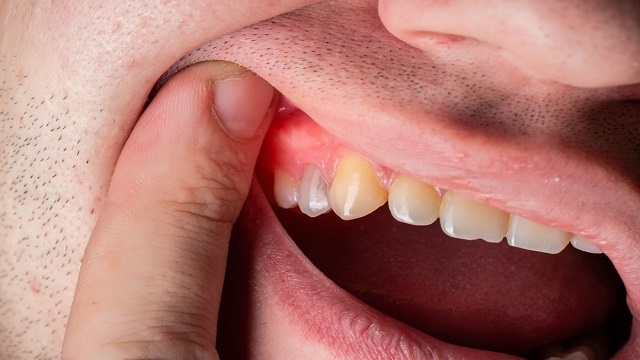Overview
An abscessed tooth is a tooth that has a pocket of pus inside the tissues around it. Pus is formed when the body tries to fight against the bacterial infection. To reduce the pain and swelling of the face and cheek caused by a dental abscess, it is recommended to apply compresses (bags) with ice on the outside of the cheek. Heat must be avoided! You can also try over-the-counter medications that relieve pain in the face or cheek.
Cause
A trauma (hit) to the tooth, an untreated cavity, or gum disease can be causes of a dental abscess. If a tooth decay is not treated, its interior – that is, the pulp of the tooth – can become infected. The bacteria can spread from the level of the tooth to the surrounding tissues and below, forming an abscess. Gum disease leads to the removal of the gum from the tooth, leaving empty spaces. If food waste accumulates in one of these spaces, bacteria will develop in that place, leading to the formation of an abscess. The abscess can lead to the destruction of the bone around the tooth.
Symptom
The following may occur:
– throbbing pain, especially during mastication (chewing) or when touching the tooth
– red, swollen gums
– an unpleasant taste in the mouth
– swelling in any area of the mouth, face, upper or lower part of the cheek or throat
– fever
– change in the color of the tooth, which becomes gray or pink
– a pimple-like swelling (a gum boil) on the side of the gum on the cheek or tongue, near the tooth
– thick yellow pus or oozing blood from a red, swollen, pimple-like area in the oral cavity
– the feeling that the tooth is pushed from its root and that the mouth can no longer be closed properly
As the infection spreads, it is possible that the pain will decrease in intensity. This happens because the nearby jawbone begins to dissolve. If too much bone is lost, the tooth will become less fixed and its extraction may be needed.
Urgent consultation of the dentist is recommended if the pain does not decrease in intensity after 2 hours after taking an anti-algesic at home. If it is a dental abscess, this can be a sign of the spread of the infection.
It is recommended to schedule a dental consultation as soon as possible in the following situations:
– mild to moderate toothache
– toothache associated with a fever of 38 degrees Celsius or more
– swelling of the oral cavity, face or cheek
– a tooth that is very sensitive or painful when pressure is applied to it (such as during mastication).
Investigations
The dentist will examine the oral cavity to identify the presence of swelling or other signs of infection that suggest the existence of a dental abscess. He will gently tap the tooth, put a warm or cold object on the tooth and examine the gum around the tooth. He will also ask you questions about the pain, how long it lasts and where exactly it is located. A dental x-ray may be necessary.
Treatment
Treatment – generalities
The dental abscess is treated by the dentist.
In the case of a dental abscess, it is recommended:
– antibiotics to destroy the bacteria that caused the infection
– a “hole” is made in the upper part or behind the tooth, so that the infection can be drained. This will usually make the pain go away.
– if necessary, a small incision is made in the swollen area near the tooth so that drainage can be done.
If the inner part (pulp) of the tooth is infected, the dentist must treat the root canal. The root canal tries to save the tooth by removing the infected pulp.
An antibiotic treatment is needed before an intervention on the root canal is performed if the respective person:
– has damaged or artificial heart valves
– presents congenital heart defects
– history of bacterial endocarditis
– suffers from diabetes or another condition that ” “weakens” the immune system
– has a liver disease (e.g. cirrhosis of the liver )
– has artificial joints, such as a hip prosthesis
– is undergoing treatment with corticosteroids for other conditions, such as Crohn’s disease or bronchial asthma
If dental canal treatment cannot be done or is ineffective, tooth extraction is recommended.
Outpatient treatment (at home)
To reduce the pain and swelling of the face and cheek caused by a dental abscess, it is recommended to apply compresses (bags) with ice on the outside of the cheek. Heat must be avoided!
You can also try over-the-counter medicines that relieve pain in the face or cheek, such as:
– Acetaminophen (Paracetamol) can reduce fever and relieve pain but does not reduce swelling
– medicines that reduce swelling (of example Ibuprofen, Naproxen or Ketoprofen)
– Aspirin, which can also reduce swelling. Some people should not take Aspirin; these are pregnant women, people who have had coagulation/bleeding problems in the past and people younger than 20 years old.
It is recommended to carefully read the medical leaflets.
Urgent consultation of the dentist is recommended if the pain does not decrease in intensity after 2 hours after taking an anti-algesic at home. If it is a dental abscess, this can be a sign of the spread of the infection.
Prophylaxis
The occurrence of a dental abscess can be prevented by preventing bacterial infections of the oral cavity. The best way to prevent bacterial infections is the proper care of the teeth and gums:
– brushing your teeth in the morning, in the evening, and after every meal. If you cannot brush your teeth after every meal, chewing sugar-free gum is recommended.
– daily use of dental floss
– regular dental consultations, which could include taking dental X-rays
– following a healthy diet, which includes whole grains, vegetables, and fruits, low in fat and salt, limiting or even avoiding the consumption of food and sweet drinks. Good nutrition helps to maintain healthy gums and prevent tooth decay.
After the dental abscess has been treated, further dental problems can be prevented by:
– tooth brushing and daily flossing
– regular dental consultations
– a healthy diet, avoiding sugary foods and drinks
– avoiding smoking or using other forms of tobacco. Tobacco use slows down the ability to heal and increases the risk of gum disease and mouth and throat cancer.
Some people may have a very dry mouth. This can cause the appearance of deep dental caries, which form quickly and which can lead to the infection of the pulp of the tooth and the evolution towards an abscess. These problems can be prevented by periodically rinsing the mouth with water, by using sugar-free chewing gum or candies. If severe symptoms of dry mouth occur, medication may be needed to treat this problem. Many medications can cause dry mouth, including medications used to treat depression and high blood pressure.




